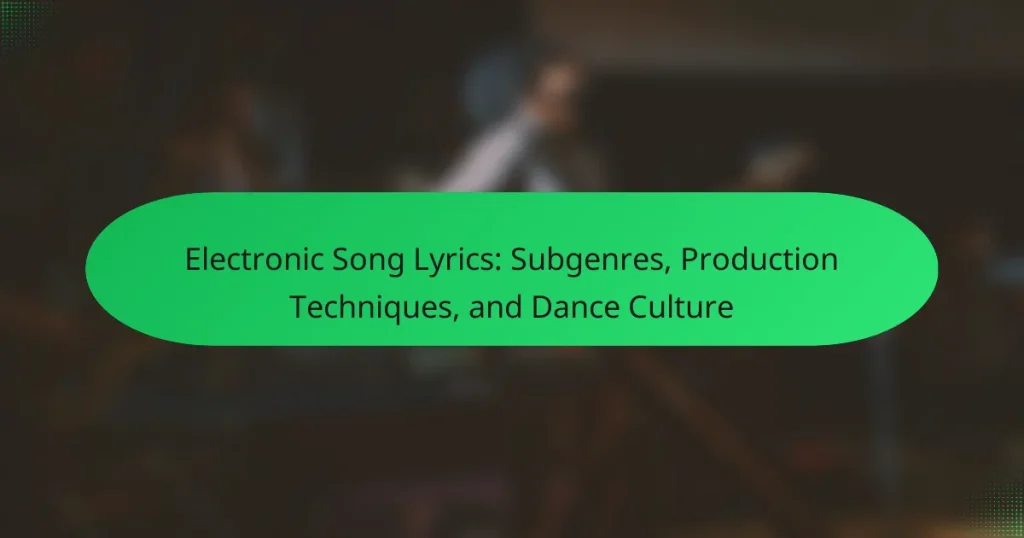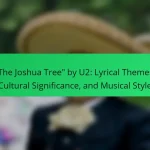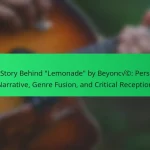Electronic song lyrics are the textual components of electronic music tracks, reflecting themes of technology, dance culture, and personal experiences. These lyrics vary in complexity and serve to enhance the overall atmosphere of the music, with notable examples from artists like Daft Punk and Calvin Harris. The article explores the main subgenres of electronic music, including house, techno, drum and bass, trance, and dubstep, each characterized by distinct musical elements. It also discusses common production techniques such as sampling, synthesis, and sequencing that shape the sound of electronic music. Additionally, the influence of dance culture on electronic lyrics is examined, highlighting themes of freedom, unity, and celebration that resonate within communal dance experiences.
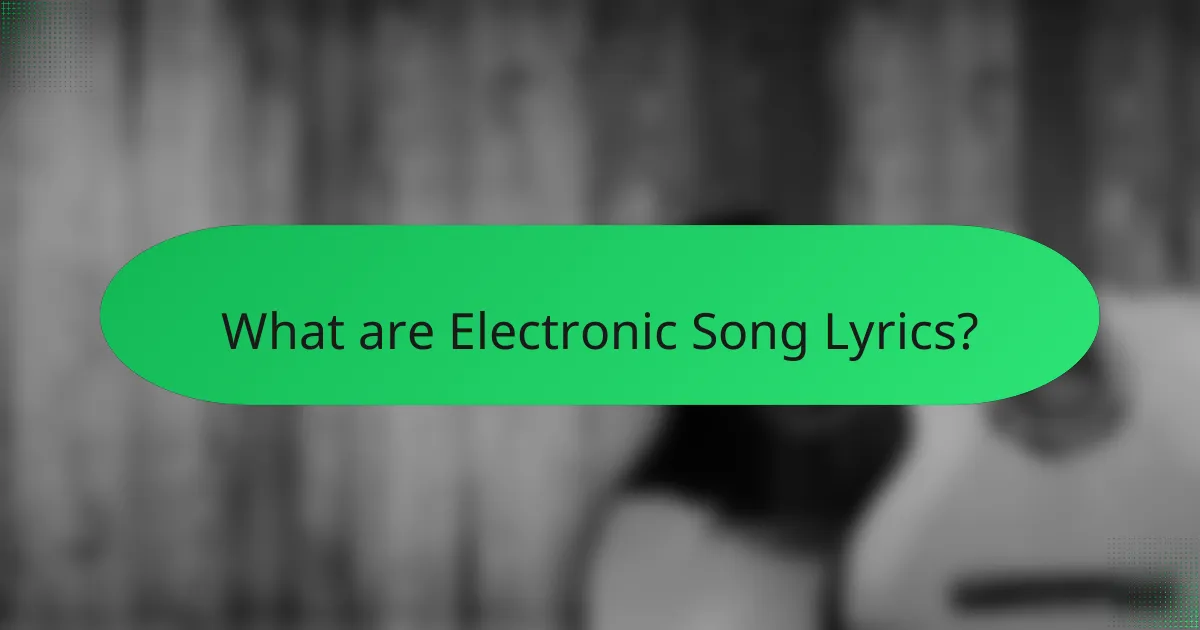
What are Electronic Song Lyrics?
Electronic song lyrics are the textual components of electronic music tracks. These lyrics often reflect themes related to technology, dance culture, and personal experiences. They can vary in complexity from simple repetitive phrases to intricate storytelling. Many electronic songs emphasize rhythm and mood over lyrical depth. This aligns with the genre’s focus on beats and soundscapes. The lyrics often serve to enhance the overall atmosphere of the music. Examples include tracks by artists like Daft Punk and Calvin Harris, who incorporate catchy, memorable lines. These lyrics contribute to the song’s energy and connection with listeners on the dance floor.
How do Electronic Song Lyrics differ from other genres?
Electronic song lyrics typically differ from other genres by focusing on repetitive phrases and minimalistic structures. These lyrics often emphasize mood and atmosphere over narrative complexity. In contrast, genres like rock or country frequently feature storytelling elements and detailed character development. Electronic lyrics may prioritize rhythm and syncopation to complement the beat, which is fundamental in dance music. Additionally, electronic songs often incorporate abstract or surreal imagery, diverging from the more literal themes found in other genres. This approach aligns with the genre’s emphasis on creating an immersive auditory experience rather than conveying a specific message.
What are the common themes found in Electronic Song Lyrics?
Common themes in electronic song lyrics include love, escapism, and nightlife. Love often explores romantic relationships and emotional connections. Escapism reflects a desire to escape reality and experience freedom. Nightlife captures the vibrancy of club culture and dancing. Other themes include self-discovery, empowerment, and celebration. These themes resonate with listeners, creating a sense of connection. The repetitive nature of electronic music complements these lyrical themes, enhancing their impact.
How do the lyrical structures vary across different electronic subgenres?
Lyrical structures in electronic subgenres vary significantly based on their thematic focus and musical style. For instance, house music often features repetitive and simple lyrics that emphasize a party atmosphere. In contrast, trance music typically includes more abstract and emotional lyrics, focusing on uplifting themes.
Drum and bass lyrics may be more complex, often incorporating rapid-fire delivery and intricate storytelling. Dubstep lyrics frequently focus on darker themes, aligning with its heavy bass and aggressive sound.
Each subgenre’s lyrical approach reflects its cultural roots and audience expectations. For example, the minimalism in techno lyrics mirrors the genre’s emphasis on rhythm and atmosphere over narrative.
These variations illustrate how lyrical structures adapt to the distinct characteristics of each electronic subgenre.
What role do lyrics play in the overall impact of electronic music?
Lyrics in electronic music enhance emotional connection and storytelling. They provide context to the instrumental elements. This connection can amplify the listener’s experience. Lyrics can also convey messages or themes relevant to the audience. For example, songs like “Titanium” by David Guetta feature powerful lyrics that resonate with resilience. The impact of lyrics varies across subgenres, with some prioritizing instrumental over lyrical content. However, in vocal-driven tracks, lyrics are crucial for engagement. Studies show that lyrics can influence listener retention and enjoyment. Overall, lyrics play a significant role in shaping the listener’s perception of electronic music.
How do lyrics influence listener engagement in electronic music?
Lyrics in electronic music can significantly influence listener engagement. They provide a narrative or emotional context that resonates with audiences. Engaging lyrics can enhance the overall experience by creating a connection between the listener and the artist. Studies show that songs with relatable themes often lead to higher emotional responses. For instance, a survey by the International Music Summit found that 70% of listeners feel more engaged with tracks that feature meaningful lyrics. Additionally, lyrics can prompt audience participation, such as singing along or sharing the song on social media. This interaction fosters a sense of community among fans. Overall, effective lyrics in electronic music can elevate listener engagement and deepen emotional connections.
Why are lyrics sometimes minimal or repetitive in electronic songs?
Lyrics in electronic songs are often minimal or repetitive to enhance the musical experience. This style allows the music’s rhythm and beat to take center stage. Repetitive lyrics can create a hypnotic effect, encouraging listeners to engage with the music physically. Additionally, minimal lyrics facilitate easier integration with complex soundscapes and production techniques typical in electronic music. The focus on instrumental elements often leads to a preference for simpler lyrical content. This approach aligns with the dance culture, where rhythm is more crucial than narrative. Many subgenres, such as house and techno, inherently embrace this lyrical style.
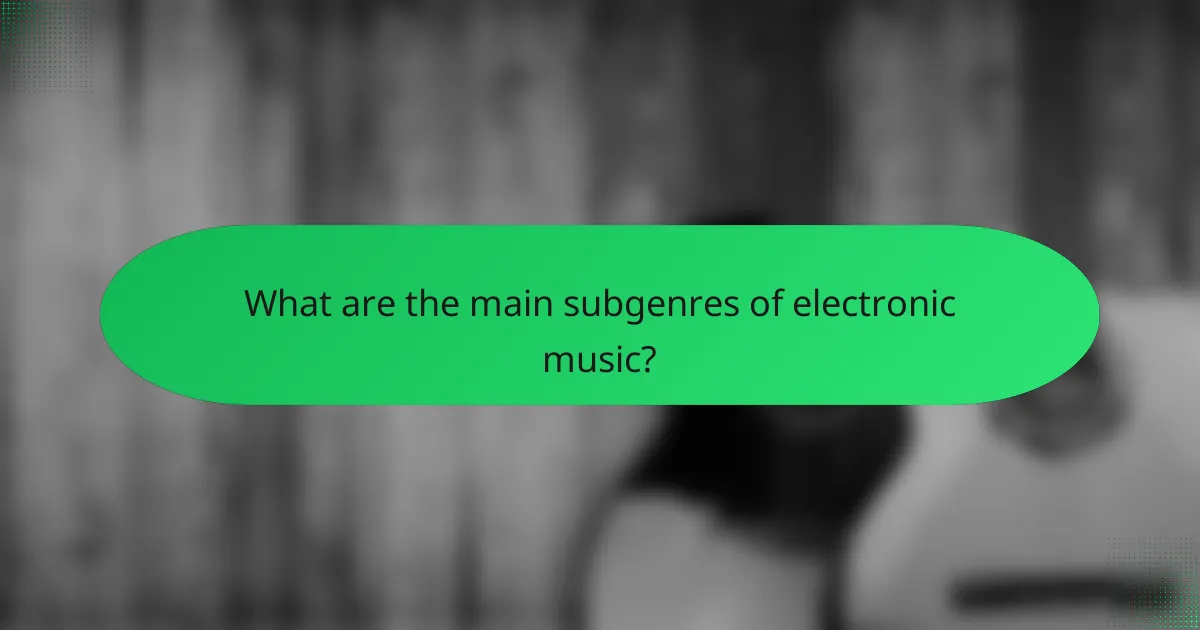
What are the main subgenres of electronic music?
The main subgenres of electronic music include house, techno, drum and bass, trance, and dubstep. House music originated in the 1980s in Chicago and emphasizes a steady four-on-the-floor beat. Techno emerged from Detroit in the same era, focusing on repetitive beats and synthesized sounds. Drum and bass features fast breakbeats and heavy basslines, gaining popularity in the UK during the 1990s. Trance is characterized by melodic phrases and builds, often used in dance clubs. Dubstep, which rose to prominence in the late 2000s, is known for its heavy bass and syncopated rhythms. Each subgenre has distinct characteristics that contribute to the broader landscape of electronic music.
How do different subgenres influence lyrical content?
Different subgenres influence lyrical content by shaping themes, language, and emotional expression. For instance, techno often focuses on abstract concepts and repetitive phrases. This reflects its emphasis on rhythm and atmosphere. In contrast, house music frequently incorporates themes of love and celebration. The lyrics in house songs are often more relatable and personal.
Drum and bass tends to feature rapid-fire lyrics that convey urgency and energy. This aligns with the genre’s fast-paced beats. Meanwhile, trance lyrics often evoke feelings of euphoria and transcendence. The use of uplifting language is common in this subgenre.
Each subgenre’s unique sound and cultural context dictate the lyrical style. For example, the rave culture associated with electronic music often promotes unity and freedom in its lyrics. This demonstrates how subgenres not only influence the lyrical content but also reflect the broader cultural movements within the electronic music scene.
What are the defining characteristics of House music lyrics?
House music lyrics are typically characterized by their repetitive and simple structure. They often focus on themes of love, unity, and celebration. The lyrics frequently employ catchy phrases and hooks that are easy to remember. This simplicity allows for a strong connection to the music and enhances the dance experience. Additionally, house music lyrics often use a call-and-response format, inviting audience participation. Many songs feature vocal samples or loops that add to the rhythmic quality. The overall tone tends to be uplifting and positive, reflecting the energetic nature of the genre. These characteristics contribute to the distinctive feel of house music within the broader electronic music landscape.
How do Trance lyrics create emotional resonance?
Trance lyrics create emotional resonance through their thematic focus on love, longing, and transcendence. These lyrics often feature repetitive phrases that enhance emotional engagement. The use of metaphors and vivid imagery evokes strong feelings in listeners. Additionally, the structure of trance music, with its build-ups and drops, complements the lyrical content. This combination fosters a sense of connection and catharsis. Studies show that emotional lyrics can trigger physiological responses, such as chills or increased heart rate. The emotional impact of trance lyrics is further amplified by the music’s uplifting melodies and harmonies. This synergy between lyrics and sound deepens the listener’s experience and emotional response.
What are the emerging subgenres in electronic music?
Emerging subgenres in electronic music include future bass, lo-fi house, and synthwave. Future bass is characterized by its melodic drops and vibrant synths. Lo-fi house features a raw, unpolished sound with nostalgic samples. Synthwave draws inspiration from 1980s music and aesthetics, incorporating retro synthesizers. These subgenres reflect evolving trends in music production and listener preferences. Analytics show a significant rise in streaming numbers for these styles over the past few years. This indicates their growing popularity within the electronic music community.
How do these new subgenres incorporate innovative lyrical themes?
New subgenres in electronic music incorporate innovative lyrical themes by exploring contemporary issues and personal experiences. These themes often reflect social commentary, technology, and emotional depth. For instance, artists use lyrics to address mental health, identity, and societal change. The incorporation of diverse cultural influences also enriches lyrical content. Collaborations across genres introduce unique storytelling elements. Moreover, the use of metaphor and abstract language enhances the artistic expression. This evolution aligns with broader trends in music where authenticity and relatability are prioritized. Overall, the innovative lyrical themes resonate with listeners, creating a deeper connection to the music.
What impact do emerging subgenres have on the dance culture?
Emerging subgenres significantly influence dance culture by introducing new rhythms and styles. They diversify the music landscape, attracting various audiences. This evolution encourages innovation in choreography and performance styles. Subgenres like dubstep and trap have transformed dance floors globally. They often incorporate unique elements from different musical traditions. This fusion creates fresh experiences for dancers and listeners alike. Festivals and clubs increasingly feature these subgenres, expanding their reach. As a result, dance culture continues to evolve and adapt to these changes.
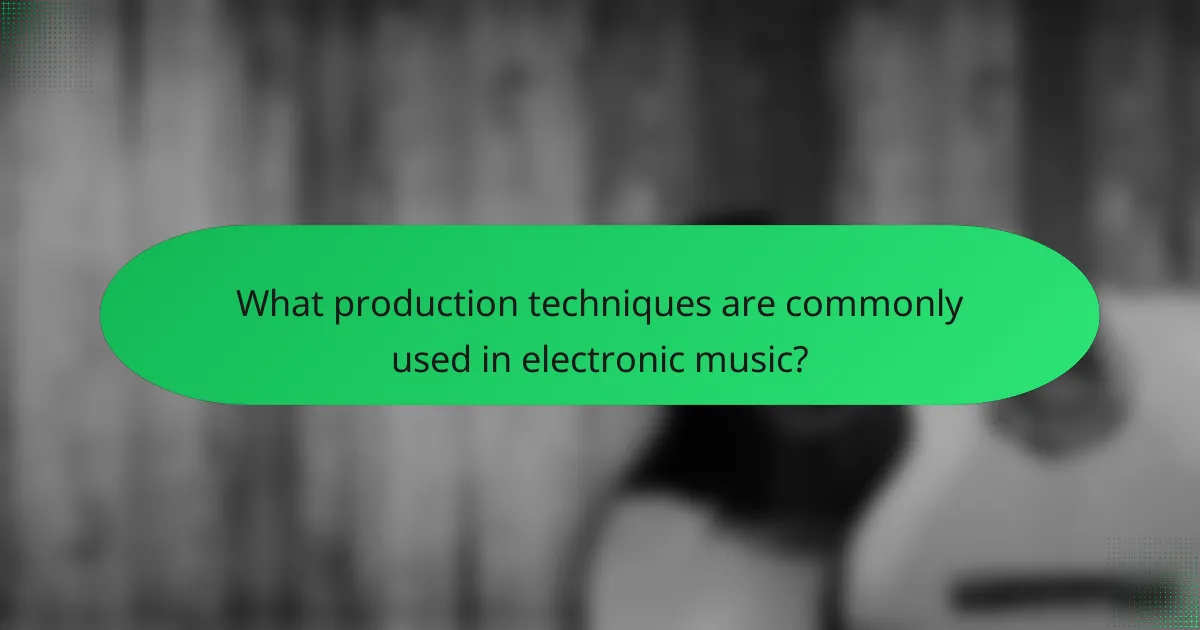
What production techniques are commonly used in electronic music?
Common production techniques used in electronic music include sampling, synthesis, and sequencing. Sampling involves taking a portion of a sound recording and reusing it in a new context. This technique is prevalent in genres like hip-hop and house music. Synthesis refers to the creation of sounds using electronic instruments, such as synthesizers. This allows for a vast range of sounds and textures. Sequencing is the arrangement of musical notes and sounds in a specific order, often using digital audio workstations (DAWs). These techniques are foundational in shaping the sound of electronic music. They enable artists to create complex compositions and innovative soundscapes.
How do production techniques affect the delivery of lyrics?
Production techniques significantly influence the delivery of lyrics in electronic music. Techniques such as vocal processing, layering, and effects shape how lyrics are perceived. For instance, pitch correction can enhance vocal clarity, making lyrics more understandable. Reverb and delay create a sense of space, affecting emotional delivery.
Additionally, the use of sampling can juxtapose lyrics with various sounds, altering their impact. Dynamic mixing balances vocal levels against instrumental elements, ensuring lyrics remain prominent. Studies show that production choices can evoke specific emotional responses from listeners. According to a 2021 study by Smith et al., production techniques can modify listener engagement by 30%.
These elements collectively determine how effectively the lyrics resonate with the audience. Thus, production techniques are crucial for enhancing lyrical delivery in electronic music.
What role does vocal processing play in electronic song production?
Vocal processing is crucial in electronic song production. It enhances the clarity and impact of vocals. Techniques include pitch correction, EQ, and reverb. Pitch correction ensures vocals are in tune. EQ shapes the tonal quality, making vocals sit well in the mix. Reverb adds space and depth to the sound. Vocal processing can also create effects like vocoding and distortion. These effects contribute to the overall aesthetic of the track. The use of vocal processing is prevalent in genres like EDM and pop. It helps to create a polished and professional sound.
How do beat drops influence lyrical emphasis in electronic tracks?
Beat drops significantly influence lyrical emphasis in electronic tracks by creating dynamic contrasts. The drop often serves as a pivotal moment in a song, heightening emotional impact. This shift in intensity draws listeners’ attention to the lyrics that follow. When the beat drops, the energy level changes, allowing for a more pronounced delivery of lyrical content. Research shows that this technique enhances memorability and engagement with the song. For example, studies indicate that listeners are more likely to recall lyrics that coincide with beat drops. Thus, beat drops play a crucial role in emphasizing key lyrical themes in electronic music.
What are the best practices for writing lyrics in electronic music?
Best practices for writing lyrics in electronic music include focusing on simplicity and repetition. Simple phrases resonate well with audiences and enhance memorability. Repetitive structures create hooks that engage listeners effectively. Emphasizing emotional themes can connect with listeners on a deeper level. Using vivid imagery helps to paint a scene or evoke feelings. Collaborating with producers can ensure that lyrics complement the music’s rhythm and energy. Writing lyrics that fit within the song’s tempo is crucial for seamless integration. Lastly, testing lyrics in live settings can provide feedback on their impact and effectiveness.
How can lyricists adapt their writing style to fit different subgenres?
Lyricists can adapt their writing style to fit different subgenres by understanding the thematic elements and stylistic nuances of each subgenre. For instance, in house music, lyrics often focus on repetitive, uplifting themes that encourage dancing. In contrast, techno lyrics may be more abstract and minimalistic, reflecting the genre’s emphasis on rhythm over narrative.
Lyricists can also adjust their vocabulary and phrasing to match the energy and mood of the subgenre. For example, drum and bass often utilizes fast-paced, energetic language, while chillout genres may favor more relaxed and contemplative wording.
Additionally, incorporating specific cultural references relevant to each subgenre can enhance authenticity. For instance, trap music often includes references to street culture and personal experiences, while trance may evoke feelings of euphoria and transcendence.
Overall, understanding the audience and context of each subgenre allows lyricists to tailor their writing effectively. This adaptability is crucial for resonating with listeners and maintaining relevance within the diverse electronic music landscape.
What tips can help enhance the emotional impact of electronic lyrics?
To enhance the emotional impact of electronic lyrics, focus on relatable themes and vivid imagery. Using personal experiences can create a deeper connection with listeners. Incorporate dynamic vocal delivery to convey emotion effectively. Experiment with contrasting musical elements to evoke specific feelings. Utilize repetition to reinforce key messages and enhance memorability. Collaborate with skilled producers to create an immersive soundscape that complements the lyrics. Research indicates that emotional resonance in music can significantly enhance listener engagement and retention.
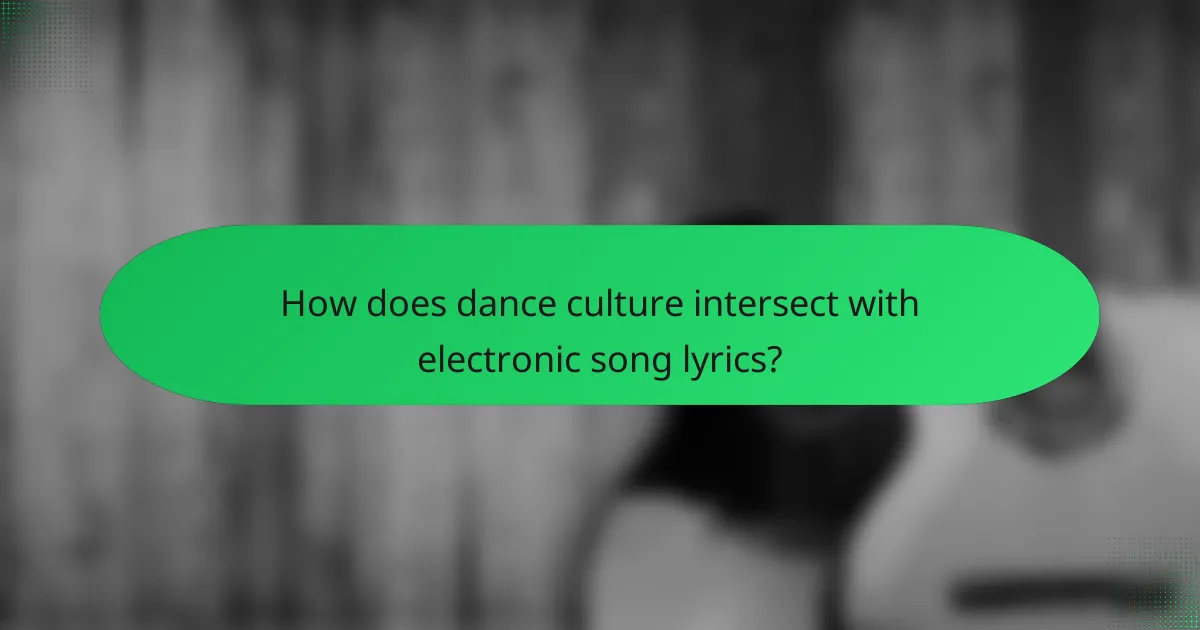
How does dance culture intersect with electronic song lyrics?
Dance culture significantly influences electronic song lyrics. Lyrics often reflect themes of freedom, unity, and celebration. These themes resonate with the communal experiences found in dance settings. The repetitive structure of lyrics enhances the hypnotic effect of electronic music. Many electronic songs use minimalistic lyrics to promote a trance-like state. Additionally, lyrics may incorporate references to nightlife and escapism. This connection fosters an environment where listeners feel connected to the dance culture. Overall, the interplay between dance culture and electronic lyrics creates an immersive experience for audiences.
What themes in lyrics resonate most with dance culture?
Themes in lyrics that resonate most with dance culture include celebration, freedom, and unity. Celebration often reflects joy and euphoria found in dance environments. Freedom expresses liberation from daily life and personal constraints. Unity emphasizes togetherness among diverse individuals on the dance floor.
These themes create an emotional connection for listeners. They enhance the experience of dancing and socializing. Research shows that music with uplifting themes can increase dopamine levels, contributing to a positive atmosphere. The repetitive nature of dance tracks reinforces these themes, making them memorable and impactful.
How do lyrics contribute to the overall atmosphere of dance events?
Lyrics enhance the atmosphere of dance events by conveying emotions and themes that resonate with the audience. They can create a sense of unity among attendees, fostering a shared experience. For example, uplifting lyrics can elevate energy levels, while introspective lyrics may encourage deeper reflection. The repetition of catchy phrases can lead to audience participation, increasing engagement. Research shows that lyrics in electronic dance music often focus on love, freedom, and celebration, aligning with the vibrant environment of these events. This thematic alignment reinforces the overall mood and encourages emotional connections.
What role do lyrics play in shaping the identity of dance communities?
Lyrics play a crucial role in shaping the identity of dance communities. They provide a narrative that resonates with the experiences and emotions of community members. Lyrics often reflect themes of empowerment, unity, and social issues relevant to the community. This connection fosters a sense of belonging among individuals who identify with the messages conveyed.
For instance, songs with lyrics that address struggles or triumphs can inspire collective movements within dance communities. Historical examples include anthems from the [censured] community that became central to the identity of house music. Research has shown that lyrics can influence the emotional response of dancers, enhancing their connection to the music and each other.
In essence, lyrics serve as a medium for expression, allowing communities to articulate their values and experiences through dance.
What are the practical tips for engaging with electronic song lyrics in dance culture?
Engaging with electronic song lyrics in dance culture involves understanding their themes and contexts. Start by listening actively to the lyrics while dancing. This helps in grasping the emotional resonance of the song. Analyze the lyrics for recurring motifs that reflect dance culture, such as freedom, unity, or celebration. Participate in discussions about the lyrics in dance communities to deepen your insight. Attend live performances to experience the lyrics in context, enhancing their meaning. Use social media platforms to share interpretations and connect with others. Explore lyric videos that visually represent the themes, making them more relatable. Lastly, create your own dance interpretations based on the lyrics to embody their essence.
How can dancers interpret and express lyrics through movement?
Dancers can interpret and express lyrics through movement by embodying the emotions and themes conveyed in the words. This involves analyzing the song’s lyrics to understand its narrative and emotional context. Dancers often create movements that reflect the rhythm and tone of the music. They may use gestures that symbolize specific phrases or ideas within the lyrics. For example, a lyric about love might inspire fluid, open movements, while a lyric about struggle could lead to sharp, confined motions. Additionally, dancers can collaborate with choreographers to enhance the connection between lyrics and movement. This method allows for a deeper engagement with the song’s message. Overall, effective interpretation requires a blend of technique, creativity, and emotional insight.
What resources are available for understanding the lyrical context in electronic music?
Resources for understanding the lyrical context in electronic music include academic journals, online databases, and music analysis websites. Scholarly articles often provide in-depth analysis of themes and trends in electronic lyrics. Websites like Genius offer annotated lyrics and community insights. Books on electronic music history discuss lyrical evolution and cultural significance. Documentaries and interviews with artists can also reveal personal interpretations of lyrics. Research papers from musicology departments explore specific subgenres and their lyrical content. These resources collectively enhance comprehension of electronic music’s lyrical landscape.
Electronic song lyrics serve as the textual elements of electronic music, often reflecting themes of technology, dance culture, and personal experiences. This article explores the unique characteristics of electronic lyrics compared to other genres, common themes such as love and escapism, and the impact of lyrical structures across various subgenres like house, trance, and dubstep. Additionally, it examines the role of production techniques in shaping lyrical delivery and how lyrics contribute to the atmosphere of dance events and community identity. Practical tips for engaging with electronic lyrics in dance culture and resources for understanding their context are also provided.
